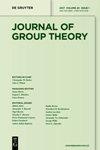全射影阿贝尔的交换子自同态𝑝-groups
IF 0.5
3区 数学
Q4 MATHEMATICS
引用次数: 0
摘要
对于一个初等阿别群𝐺,Chekhlov和Danchev(2015)通过将人们的注意力限制在所有对易子自同态集合生成的𝐺自同态环的子群、子带和酉子带上,定义了Kaplansky的完全可及性概念的三个变体。他们提出了一个问题,即准确地描述哪些全射影群表现出这些形式的完全及物性。这个问题,以及一些密切相关的问题,都可以通过𝐺的Ulm函数得到完全的解答。本文章由计算机程序翻译,如有差异,请以英文原文为准。
Commutator endomorphisms of totally projective abelian 𝑝-groups
Abstract For a primary abelian group 𝐺, Chekhlov and Danchev (2015) defined three variations of Kaplansky’s notion of full transitivity by restricting one’s attention to the subgroup, the subring and the unitary subring of the endomorphism ring of 𝐺 generated by the collection of all commutator endomorphisms. They posed the problem of describing exactly which totally projective groups exhibit these forms of full transitivity. This problem, and some closely related questions, are completely answered using the Ulm function of 𝐺.
求助全文
通过发布文献求助,成功后即可免费获取论文全文。
去求助
来源期刊

Journal of Group Theory
数学-数学
CiteScore
1.00
自引率
0.00%
发文量
45
审稿时长
6 months
期刊介绍:
The Journal of Group Theory is devoted to the publication of original research articles in all aspects of group theory. Articles concerning applications of group theory and articles from research areas which have a significant impact on group theory will also be considered.
Topics:
Group Theory-
Representation Theory of Groups-
Computational Aspects of Group Theory-
Combinatorics and Graph Theory-
Algebra and Number Theory
 求助内容:
求助内容: 应助结果提醒方式:
应助结果提醒方式:


